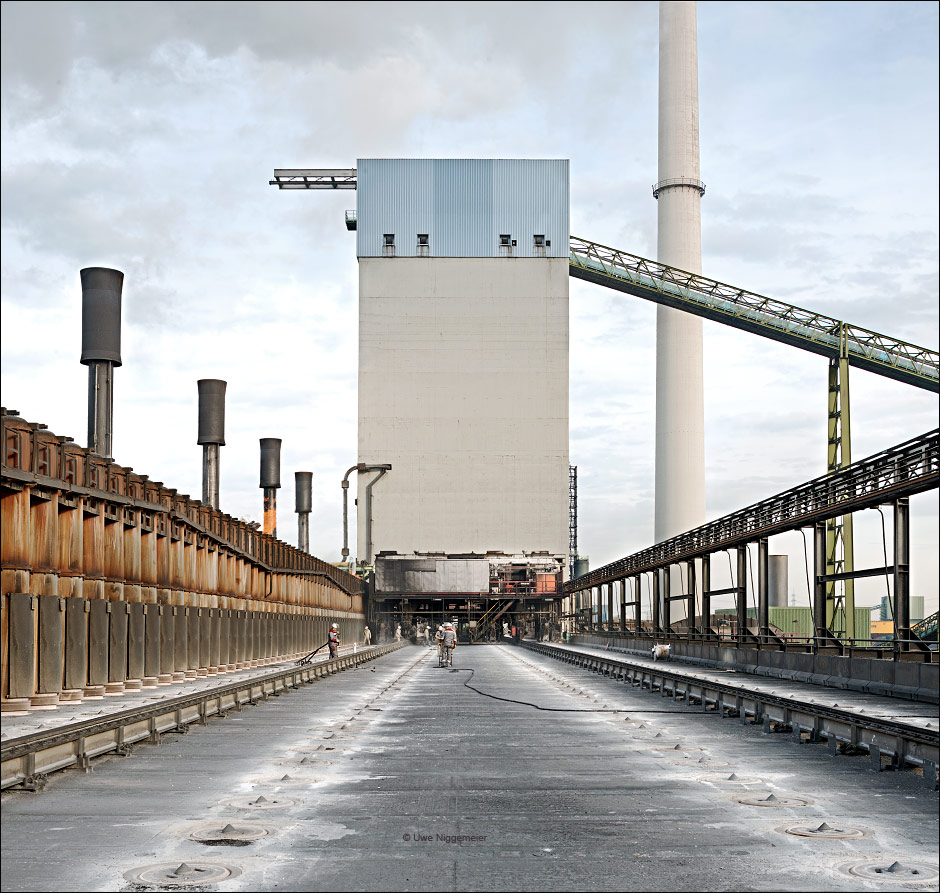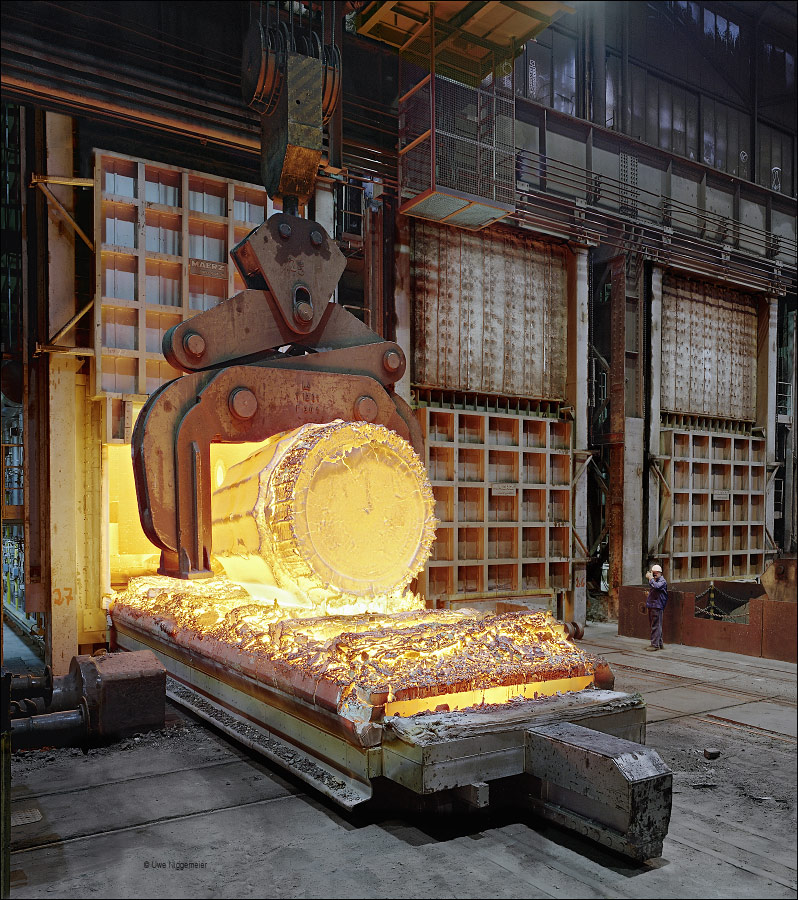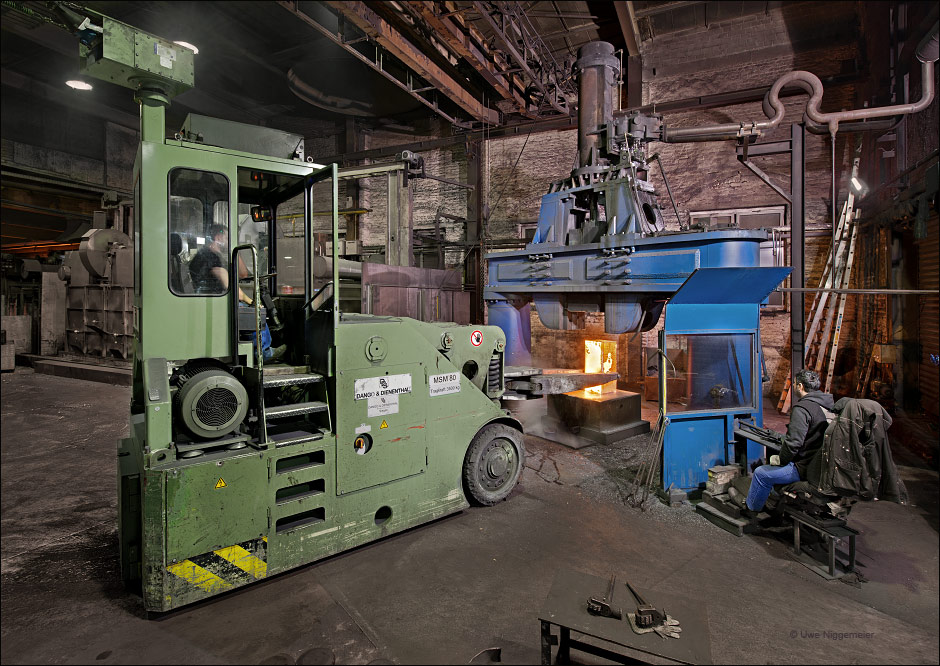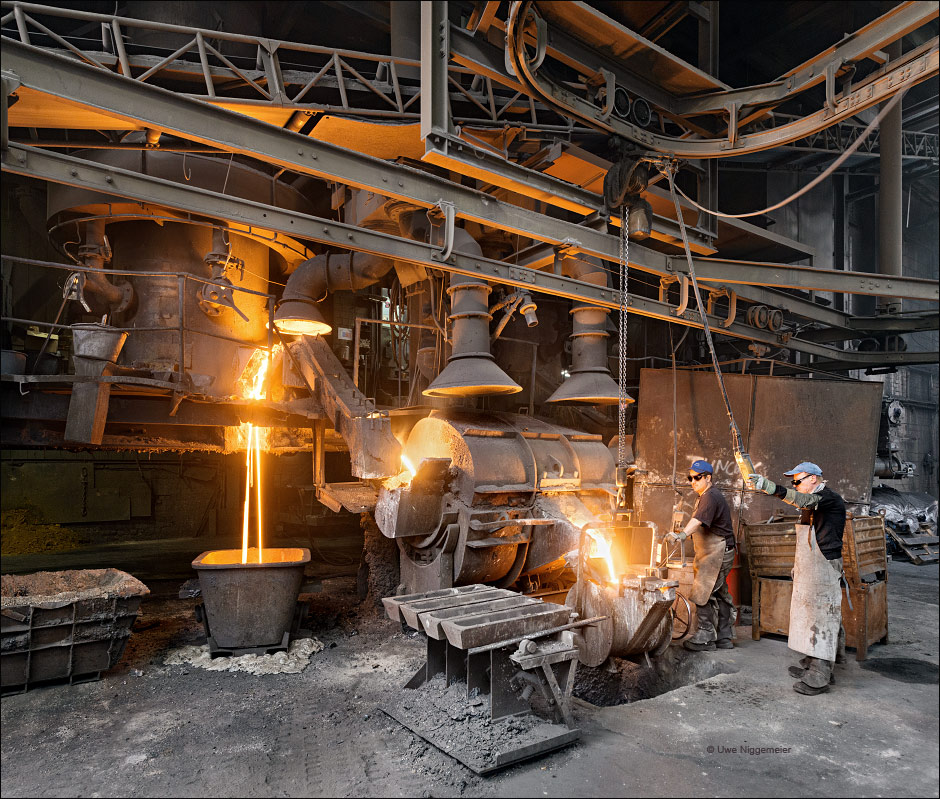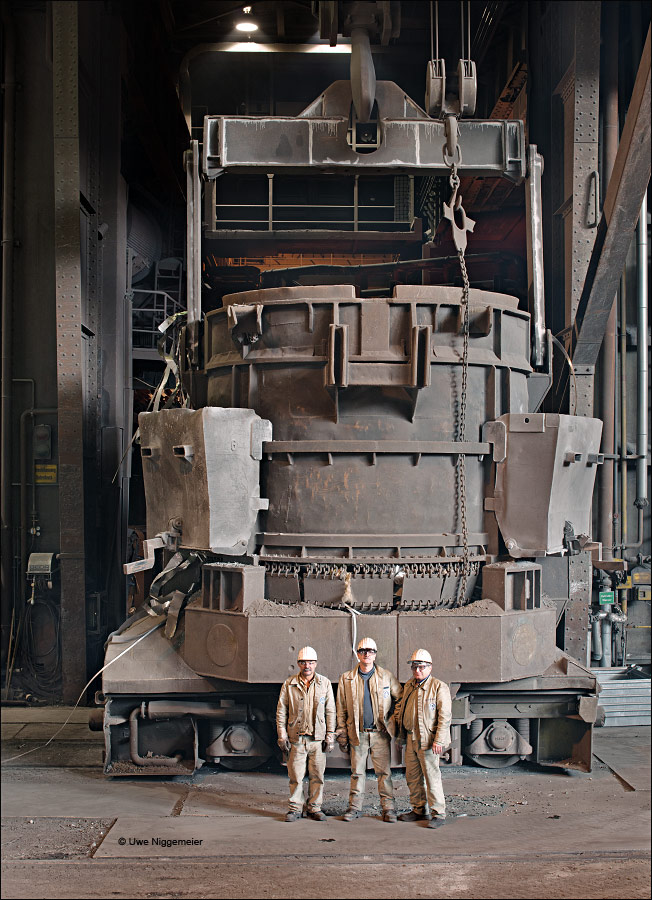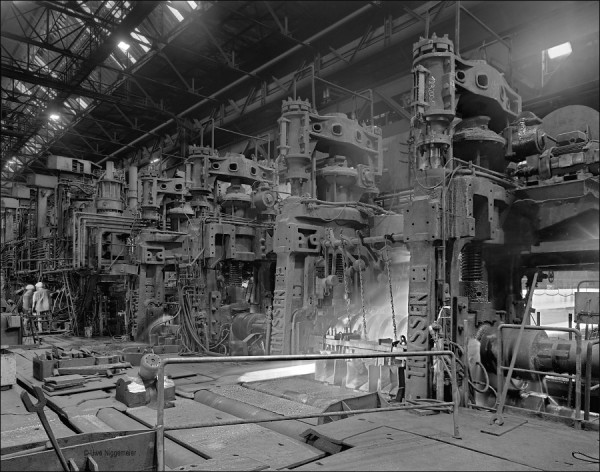The new coking plant Schwelgern in Duisburg, Germany was commmissioned by ThyssenKrupp in 2003 replacing the old August-Thyssen coke ovens.
Two batteries of 70 ovens each were built.
Some images now at Stahlseite.
Category Archives: Germany
Buderus Edelstahl Revisited
Additional images now at Stahlseite.
The Wetzlar works were founded by “Röchlingsche Eisen und Stahlwerke” and Buderus in 1920.
A new melt shop was erected in 1939.
In 1965 Buderus took over and in 2005 the Austrian steel company Böhler Uddeholm acquired the mill.
Nowadays Buderus Edelstahl produces about 300000 tons of crude steel in an electric arc furnace. All steel is casted into ingots.
The further production line includes a blooming mill, a hot strip rolling mill, three open die forging presses and a closed die forge.
Steam Hammers
The Wilhelm Sönnecken forge in Wuppertal, Germany was founded in 1891. Nowadays 5 steam hammers are in use producing mainly round forgings often used for gearwheels.
Images.
Back At Germany’s Largest Steam Hammer
Dörrenberg Edelstahl
A small steel mill with a long history. Dörrenberg Edelstahl in Engelskirchen-Ründeroth, Germany produces ingots, steel castings and investment castings.
Images now on my website.
The steel mill in Engelskirchen-Ründeroth was purchased by the Dörrenberg brothers in 1869 and subsequently became a leading producer of high alloyed tool steels.
A crucible steel making shop, hammer forges and mechanical shops were installed.
In 1916 an open hearth melt shop was commissioned.
The first induction furnaces used for steel production in Germany were built in 1928 in Ründeroth.
The electric arc furnace was commisioned in 1951. All forging activities ended in 1992. Since 1996 Dörrenberg Edelstahl is part of the Gesco-Group.
Foundry Capital
Velbert, Germany in the 1960ies was a busy town mainly living of it’s more than 30 foundries. 7000 people produced mostly small iron castings for household appliances, keys and the car industry.
Gestaguss is the last survivor of this once thriving business.
Further viewing at Stahlseite.
The Gestaguss foundry in Velbert was established in 1919 under the name Bergisch-Märkisches Eisenwerk (BME).
The BME specialized in malleable iron castings. Domestic appliances like meat grinders were built at their own workshop.
After 1990 the foundry filed bancruptcy several times and was taken over by the Gestaguss group in 2011.
The foundry produces castings with a weight of up to 30 kg from two cold blast cupola furnaces. It is one of the last malleable iron producers in Germany.
It’s Over
The Nirosta Krefeld melt shop was closed on Friday, 6th of December after more than 110 years of steel making.
I had the chance for a last visit three weeks before.
Now at my website.
The steel mill in Krefeld, Germany was established in 1900 by Carl Spaeter, Peter Klöckner and August Thyssen under the name Krefelder Stahlwerk AG. Open hearth steel production started in 1901. In 1907 three rolling mills were installed. In 1911 a tube mill was added. A forging press went into production in 1917.
In 1927 the Krefeld mill became part of the speciality steel group Deutsche Edelstahlwerke AG out of Bochum, Germany.
The first electric arc furnace was installed in 1930.
The new melt shop number 3 including two 70 ton electric arc furnaces was built by DEMAG in 1952.
A new wire mill started rolling in 1963.Open hearth steel making ceased in 1970.The year 1971 saw the complete takeover by the August Thyssen Hütte AG from Duisburg.
The new name from 1974 on was Thyssen Edelstahlwerke AG the Krefeld mill was merged now with Edelstahlwerk Witten AG.
In 1977 the first of two 80 ton AOD-converters was installed by the GHH company.Two rolling mills were closed in 1982.
In 1985 one electric arc furnace was modernised and the other one closed down. In 1989 the old melt shop NO 1 (30 ton furnace) was closed.The wire mill was shut down in 1993.
A new name in 1994: Edelstahlwerke Witten-Krefeld GmbH.
Krefeld merged with Krupp’s Bochum based stainless steel mill to form Krupp Thyssen Nirosta GmbH in 1995.
All forging activities in Krefeld came to EWK (now Deutsche Edelstahlwerke). A strip caster was installed in 2001.
VAI Siemens installed two new 80 ton AOD-converters in 2009.
The Finnish Outokumpu group takes over the Nirosta mills (now called Inoxum) in 2012.
Big Cupola V

The Walter Hundhausen foundry was established in 1914 in Gevelsberg, Germany.
After WWI the company moved 25 km to Schwerte at the eastern edge of the Ruhr area.
In 1928 the production of black heart malleable castings started.
Heavy truck axle components became a main product after WWII.
Walter Hundhausen was taken over by the Hoesch steel company from Dortmund in 1989 and became part of Krupp Hoesch Automotive four years later. 1993 closure of the branch plant in Werdohl.
In 2000 the Walter Hundhausen iron foundry was taken over by the GMH group from Georgsmarienhütte.
A new large 40t/h cupola furnace replaced the old induction furnaces in 2008. The foundry employes more than 600 people.
Further images at Stahlseite.
The Last German Rail
was rolled yesterday at the TSTG rail mill in Duisburg.
The rolling mill exists since 1894 built by the August Thyssen Hütte and sold to the Austrian Voest Alpine group in 2001.
Voest is still producing rails at it’s Donawitz works in Austria.
TSTG’s finishing stands were built in 1924 named “Fertigstrasse 1” back then.
Some images.
Big Cupola IV
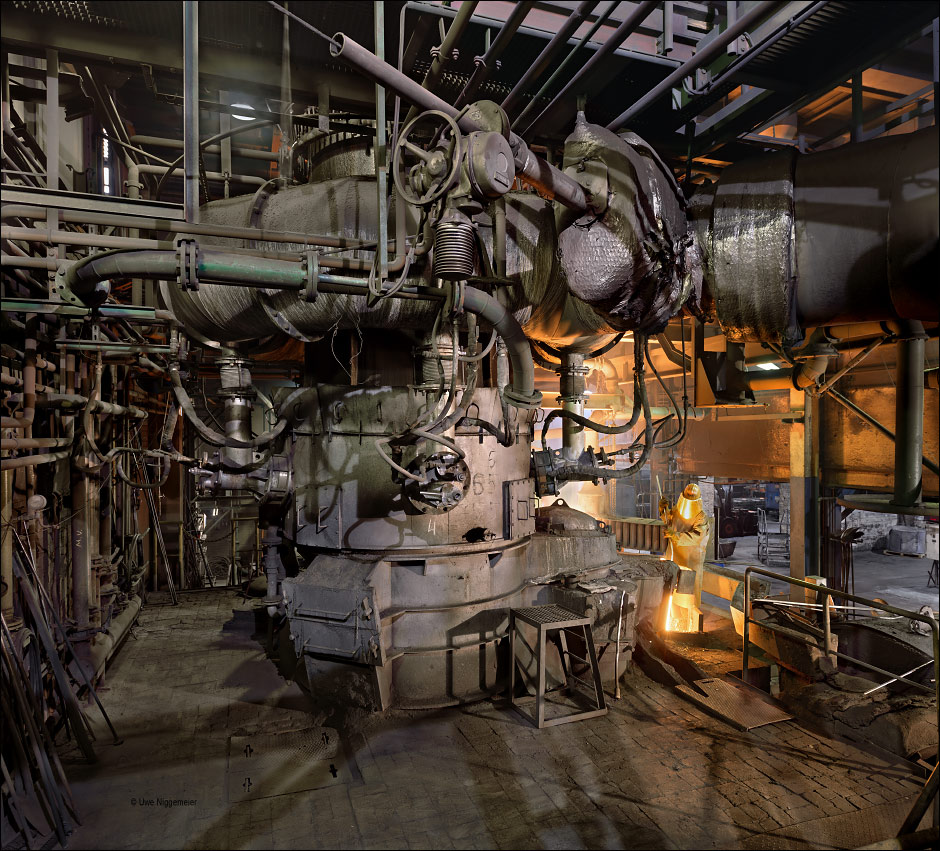
This is the old Carlshütte in Limburg, Germany, better known as Buderus Eisenwerke for more than a century.
The company was founded in 1900 by Carl Schlenck from Nürnberg.
In 1907 the Buderus company took the mill over to produce sewer and drainage castings.
Four cupola furnaces were installed. During world war II. a converter for steel castings was in use.
During the 1950ies and 60ies more than 1200 people were employed.
In 1979 a new hot blast cupola furnace was built.
In 2009 the former Buderus Kanalguss was bought by the MeierGuss group.
Further images.

